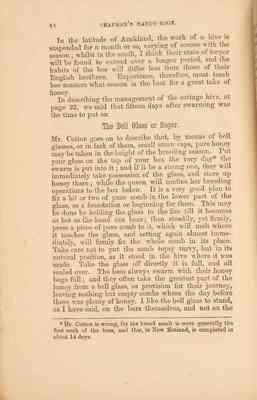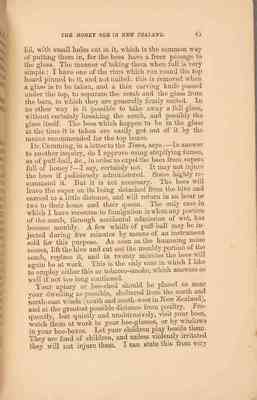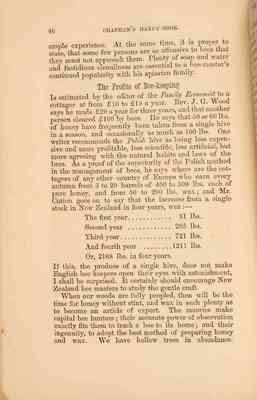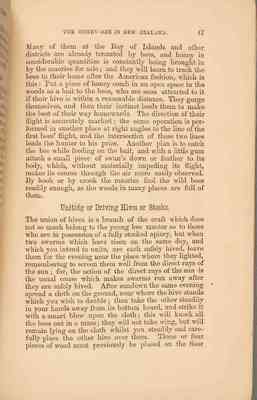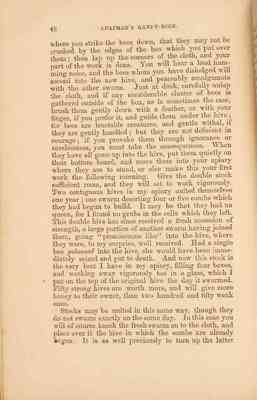Pages
44 CHAPMAN'S HANDY-BOOK.
In the latitude of Auckland, the work of a hive is suspended for a month or so, varying of course with the season; whilst in the south, I think their state of torpor will be found to extend over a longer period, and the habits of the bee will differ less from those of their English brethren. Experience, therefore, must teach bee masters what season is the best for a great take of honey. In describing the management of the cottage hive, at page 22, we said the fifteen days after swarming was the time to put on The Bell Glass or Super. Mr. Cotton goes on to describe that, by means of bell glasses, or in lack of them, small straw caps, pure honey may be taken in the height of the breeding season. Put your glass on the top of your box the very day* the swarm is put into it; and if it be a strong one, they will immediately take possession of the glass, and store up honey there; while the queen will confine her breeding operations to the box below. It is a very good plan to fix a bit or two of pure comb in the lower part of the glass, as a foundation or beginning for them. This may be done by holding the glass to the fire till it becomes as hot as the hand can bear; then steadily, yet firmly, press a piece of pure comb to it, which will melt where it touches the glass, and setting again almost immediately, will firmly fix the whole comb in its place. Take care not to put the comb topsy turvy, but in its natural position, as it stood in the hive where it was made. Take the glass off directly it is full, and all sealed over. The bees always swarm with their honey bags full; and they often take the greatest part of the honey from a bell glass, as provision for their journey, leaving nothing but empty combs where the day before there was plenty of honey. I like the bell glass to stand, as I have said, on the bars themselves, and not on the _______________________________________________ *Mr. Cotton is wrong, for the brood comb is more generally the first work of the bees, and this, in New Zealand, is completed in about 14 days.
THE HONEY BEE IN NEW ZEALAND. 45
lid, with small holes cut in it, which is the common way of putting them in, for the bees have a freer passage to the glass. The manner of taking them when full is very simple: I have one of the rims which run round the top board pinned to it, and not nailed: this is removed when a glass is to be taken, and a thin carving knife passed under the top, to separate the comb and the glass from the bars, to which they are generally firmly united. In no other way is it possible to take away a full glass, without certainly breaking the comb, and possibly the glass itself. The bees which happen to be in the glass at the time it is taken are easily got out of it by the means recommended for the top of boxes. Dr. Cumming, in a letter to the TIMES, says: - In answer to another inquiry, do I approve using stupifying fumes, as of puff-ball, &c., in order to expel the bees from supers full of honey? - I say, certainly not. It may not injure the bees if judiciously administered. Some highly recommend it. But it is not necessary. The bees will leave the super on its being detached from the hive and carried to a little distance, and will return in an hour or two to their home and their queen. The only case in which I have recourse to fumigation is when any portion of the comb, through accidental admission of wet, has become mouldy. A few whiffs of puff-ball may be injected during five minutes by means of an instrument sold for this purpose. As soon as the humming noise ceases, lift the hive and cut out the mouldy portion of the comb, replace it, and in twenty minutes the bees will again be at work. This is the only case in which I like to employ either this or tobacco-smoke, which answers as well if not too long continued. Your apiary or bee-shed should be placed as near your dwelling as possible, sheltered from the north and north-east winds (south and south-west in New Zealand), and at the greatest possible distance from poultry. Frequently, but quietly and unobtrusively, visit your bees, watch them at work in your bee-glasses, or by windows in your bee-boxes. Let your children play beside them. They are fond of children, and unless violently irritated they will not injure them. I can state this from very
46 CHAPMAN'S HANDY-BOOK.
ample experience. At the same time, it is proper to state, that some few persons are so offensive to bees that they must not approach them. Plenty of soap and water and fastidious cleanliness are essential to a bee-master's continued popularity with his apiarian family. The Profits of Bee-keeping Is estimated by the editor of the FAMILY ECONOMIST to a cottager at from &10 to &15 a year. Rev. J. G. Wood says he made &20 a year for three years, and that another person cleared &100 by bees. He says that 50 or 60 lbs. of honey have frequently been taken from a single hive in a season, and occasionally as much as 100 lbs. One writer recommends the POLISH hive as being less expensive and more profitable, less scientific, less artificial, but more agreeing with the natural habits and laws of the bees. As a proof of the superiority of the Polish method in the management of bees, he says where are the cottagers of any other country of Europe who earn every autumn from 5 to 20 barrels of 400 to 500 lbs. each of pure honey, and from 50 to 200 lbs. wax; and Mr. Cotton goes on to say that the increase from a single stock in New Zealand in four years was :- The first year .................. 31 lbs. Second year ...................205 lbs. Third year ......................721 lbs. And fourth year .............1211 lbs. Or 2168 lbs. in four years. If this, the produce of a single hive, does not make English bee keepers open their eyes with astonishment, I shall be surprised. It ceratainly should encourage New Zealand bee masters to study the gentle craft. When our woods are fully peopled, then will be the time for honey without stint, and wax in such plenty as to become an article of export. The maories make capital bee hunters; their accurate power of observation exactly fits them to track a bee to its home; and their ingenuity, to adopt the best method of producing honey and wax. We have hollow trees in abundance.
THE HONEY-BEE IN NEW ZEALAND 47
Many of them at the Bay of Islands and other districts are already tenanted by bees, and honey in considerable quantities being brought in by considerable quantities is constantly being brought in by the maories for sale ; and they will learn to track the the bees to their home after the American fashion, which is this : Put a piece of honey comb in an open space in the woods as a bait to the bees, who are soon attracted to it if their hive is within a reasonable distance. They gorge themselves, and then their instinct leads them to make their best of their way homewards. The direction of their flight is accurately marked ; the same operation is performed in another place at right angles to the line of the first bees' flight, and the intersection of these two lines leads the hunter to his prize. Another plan is to catch the bee while feeding on the bait, and with a little gum attach a small piece of swan's down or a feather to its body, which, without materially impeding its flight, makes its course though the air more easily observed.
By hook or by crook, the maories will find the wild bees readily enough, as the woods in many places are full of them.
Uniting or Driving Hives or Stocks.
The union of hives is a branch of the craft which does not so much belong to the young bee master as to those who are in possession of a fully stocked apiary, but when two swarms which have risen on the same day, and which you intend to unite, are each safely hived, leave them for the evening near the place where they lighted, remembering to screen them well from the direct rays of the sun ; for, the action of the direct rays of the sun is the usual cause which makes swarms run away after they are safely hived. After sundown the same evening spread a cloth on the ground , near where the hive stands which you wish to double ; then take the other steadily in your hands away from its bottom board, and strike it with a smart blow upon the cloth ; this will knock all the bees out in a mass ; they will not take wing but will remain lying on the cloth ; whilst you steadily and carefully place the other hive over them. Three or four pieces of wood must previously be placed on the floor
48 CHAPMAN'S HANDY-BOOK
where you stake the bees down, that they may not be crushed by the edges of the box which you put over them ; then lap up the corners of the cloth, and your part of the work is done. You will hear a houd humming noise, and the bees whom you have dislodged will ascend into the new hive, and peaceably amalgamate with the other swarm. Just at dusk, carefully unlap the cloth, and if any considerable cluster of bees is gathered outside of the box, as is sometimes the case, brush them gently down with a feather, or with your finger, if you prefer it, and guide them under the hive ; for bees are tractable creatures, and gentle withal, if they are gently handled ; but they are not deficient in courage ; if you provoke them through ignorance or carelessness, you must take the consequences. When they have all gone up into the hive, put them quietly on their bottom board, and move them into their apiary where they are to stand, or else make this your first work the following morning. Give the double stock sufficient room, and they will set to work vigorously. Two contiguous hives in my apiary united themselves one year ; one swarm deserting four or five combs which they had begun to build. It may be that they had no queen, for I found no grubs in the cells which they left. This double hive has since received a fresh accession of strength, a large portion of another swarm having joined them, going "promiscuous like" into the hive, where they were, to my surprise, well received. Had a single bee pokonoad into the hive, she would have been immediately seized and put to death. And now this stock is the very best I have in my apiary, filling four boxes, and working away vigorously too in a glass, which I put on top of the original hive the day it swarmed. Fifty strong hives are worth more, and will give more honey to their owner, than two hundred and fifty weak ones.
Stocks may be united in this same way, though they do not swarm exactly on the same day. In this case you will of course knock the fresh swarm on to the cloth, and place over it the hive in which the combs are already begun. It is as well previously to turn up the latter
